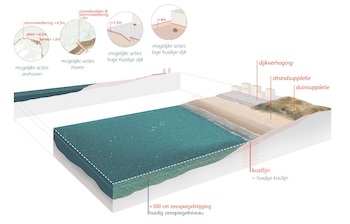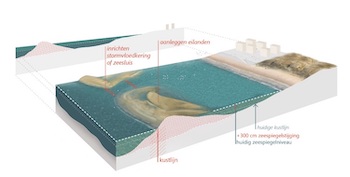M.W.J. Smit1*, W.P. Bodde1, S.Dens1, Maarten Jansen, Youri Meersschaut2
1 Witteveen+Bos,
2 MOW/AMT,
Introduction
Global climate changes are expected to affect local conditions like local water levels, waves and currents. Belgium has a 67 km long coastline with beaches, dunes, dikes, harbours and a variety of coastal defence structures like groynes and sea walls. The Belgian Coastal Policy focusses on 'soft solutions where possible and only hard structures where needed'. Based on the Masterplan Coastal Safety (www.https://afdelingkust.be/nl/masterplan-kustveiligheid), measures are currently implemented to withstand a sea level rise of 0.3 m in 2050, and 0.8 m in 2100. As the exact impact of climate change is unknow, there are various ways to deal with the uncertainty in sea level rise. Currently, the Flemish 'Complex Project Kustvisie' investigates the longterm effect of various climate scenarios on the coastal area and the subsequent possibilities for spatial use, measures and adaptations.
Methods
For a range of scenarios of sea level rise (SLR), with a maximum of 3 m, the impact on the local hydrodynamics is investigated. Possible adaptations are investigated and planned in an adaptive way. In later years (e.g. 2030 and 2050) the occurring conditions and new predictions will be used to adopt the coastal strategy.
Offshore conditions are transformed to nearshore conditions, combined with the occurring tides - which also change due to SLR. These local conditions are used in testing the current Belgian coastal defence, giving information on required extra dune volumes or strength of coastal defence structures. The space required to ensure coastal safety is combined with the space needed for other aspects like buildings, recreation, nature and economy. Solutions to meet the requirements for space are a combination of offshore constructions and measures on the beach and sea defences. An important aspect of these solutions are measures to reduce the offshore wave energy. The possibilities of solutions both offshore (reducing nearshore wave conditions) and nearshore are investigated for predefined sections of the coastline. This results in solutions strategies, which will be discussed with stake holders in order to come to preferred solutions. These will be designed in further detail at a later stage.
Results
The coastal area can be divided in several zones alongshore. Per zone the cross-shore impact and possibilities are investigated and discussed with stake holders. The location of the future coastline affects local functions and has implications for required coastal defence strategies (Figure 1). In the current project coastal engineers, spatial planners and policy makers collaborated to create a first set up for adaptive coastal management for the Belgian Coast, taking future changes into account. This process is ongoing.


Figure 6 Example of impact of 2 alternative strategies of coastal defence adaptation to sea level rise.
I. Surname1*, F.N. Another-Surname2 , Y. Next-Surname2
1 University Name, Country; 2 Organization Name, Country
* Corresponding author: mail.name@organization.org


